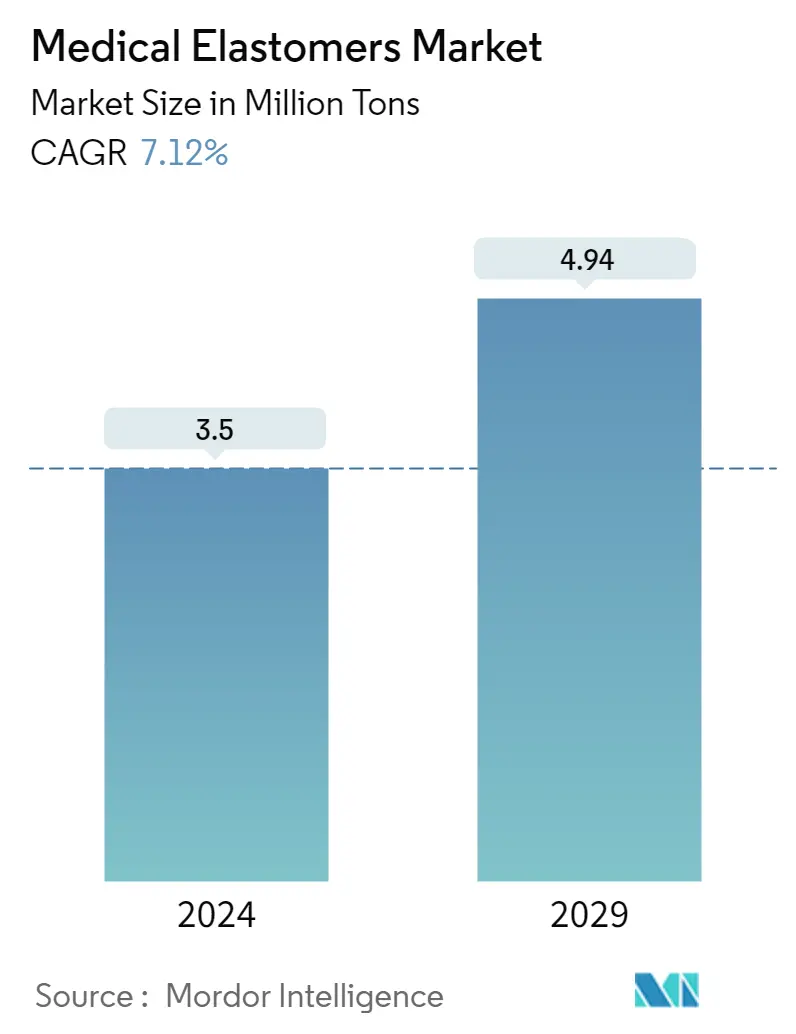Market Size of Medical Elastomers Industry

| Study Period | 2019 - 2029 |
| Base Year For Estimation | 2023 |
| CAGR (2024 - 2029) | 7.12 % |
| Fastest Growing Market | Asia-Pacific |
| Largest Market | Asia-Pacific |
| Market Concentration | Low |
Major Players.webp)
*Disclaimer: Major Players sorted in no particular order |
Medical Elastomers Market Analysis
The Medical Elastomers Market size is estimated at 3.5 Million tons in 2024, and is expected to reach 4.94 Million tons by 2029, growing at a CAGR of 7.12% during the forecast period (2024-2029).
The market was negatively impacted by COVID-19 in 2020. The nationwide lockdowns and stringent social distancing mandates led to supply chain disruptions across different segments of the market. However, the market is expected to grow steadily owing to increasing investments in healthcare.
- The demand for safe, halogen-free polymers and the shift in the medical industry toward wearable health devices and medical tools that can talk to each other from the outside are the main things driving the market.
- Decreasing usage of single-use devices and the increasing prices of silicone are the factors that may slow down the market's growth. The medical elastomer industry is moving toward sustainable and green projects as environmental awareness grows.
- The development of bio-based thermoplastic elastomers is the key market opportunity.
Asia-Pacific dominated the market across the globe, with the largest consumption in countries such as China, India, etc.
Medical Elastomers Industry Segmentation
Elastomers are major of two types - thermoset elastomers and thermoplastic elastomers. The thermoset elastomers cannot be melted and retain their structure while thermoplastic elastomers can be melted to mold into different shapes. The medical elastomer market is segmented by type into thermoplastic elastomer and thermoset elastomer. On basis of application, the market is segmented into medical tubes, catheters, syringes, non-wovens and films, gloves, medical bags, implants, and other applications. The report also covers the market sizes and forecasts for Medical Elastomers Market in 15 countries across major regions. For each segment, the market sizing and forecasts have been done based on volume (in kilo tons).
| Type | ||||||||||
| ||||||||||
|
| Application | |
| Medical Tubes | |
| Catheters | |
| Syringes | |
| Non-wovens and Films | |
| Gloves | |
| Medical Bags | |
| Implants | |
| Other Applications |
| Geography | |||||||
| |||||||
| |||||||
| |||||||
| |||||||
|
Medical Elastomers Market Size Summary
The medical elastomers market is poised for significant growth over the forecast period, driven by increasing investments in healthcare and a shift towards safe, halogen-free polymers. The market's expansion is supported by the rising demand for wearable health devices and interconnected medical tools. However, challenges such as the decreasing use of single-use devices and rising silicone prices may impede growth. The industry is also moving towards sustainable practices, with bio-based thermoplastic elastomers presenting a key opportunity. Asia-Pacific leads the market, with China and India being major consumers, supported by government initiatives to enhance healthcare infrastructure and domestic medical device innovation.
The market is characterized by a diverse range of applications, with thermoplastic elastomers (TPE) holding the largest market share. These materials are extensively used in medical tubing, film applications, and various medical devices due to their high-performance characteristics. The demand for thermoplastic polyurethanes (TPU) is also on the rise, attributed to their chemical resistance and durability. The fragmented nature of the global market sees major players like BASF SE, Celanese Corporation, DOW, Solvay, and DuPont leading the charge, with strategic acquisitions, such as Celanese's acquisition of DuPont's thermoplastics and elastomers units, further expanding their product offerings and production capacities.
Medical Elastomers Market Size - Table of Contents
-
1. MARKET DYNAMICS
-
1.1 Drivers
-
1.1.1 Rise in Demand for Safe and Halogen-free Polymers
-
1.1.2 Other Drivers
-
-
1.2 Restraints
-
1.2.1 Decreasing Usage of Single-Use Devices
-
1.2.2 Increases Prices of SIlicone
-
-
1.3 Industry Value Chain Analysis
-
1.4 Porter's Five Forces Analysis
-
1.4.1 Bargaining Power of Suppliers
-
1.4.2 Bargaining Power of Consumers
-
1.4.3 Threat of New Entrants
-
1.4.4 Threat of Substitute Products and Services
-
1.4.5 Degree of Competition
-
-
-
2. MARKET SEGMENTATION
-
2.1 Type
-
2.1.1 Thermoplastic Elastomer
-
2.1.1.1 Styrenic Block Copolymers (SBC)
-
2.1.1.2 Thermoplastic Polyurethane (TPU)
-
2.1.1.3 Plasticized Polyvinyl Chloride (PVC)
-
2.1.1.4 Thermoplastic Vulcanizate (TPV)
-
2.1.1.5 Other Thermoplastic Elastomers
-
-
2.1.2 Thermoset Elastomer
-
2.1.2.1 Silicones
-
2.1.2.1.1 Liquid silicone rubber (LSR)
-
2.1.2.1.2 High consistency rubber (HCR)
-
2.1.2.1.3 Other Silicones
-
-
2.1.2.2 Natural Rubber (Latex)
-
2.1.2.3 Butyl Rubber
-
2.1.2.4 Other Thermoset Elastomers
-
-
-
2.2 Application
-
2.2.1 Medical Tubes
-
2.2.2 Catheters
-
2.2.3 Syringes
-
2.2.4 Non-wovens and Films
-
2.2.5 Gloves
-
2.2.6 Medical Bags
-
2.2.7 Implants
-
2.2.8 Other Applications
-
-
2.3 Geography
-
2.3.1 Asia-Pacific
-
2.3.1.1 China
-
2.3.1.2 India
-
2.3.1.3 Japan
-
2.3.1.4 South Korea
-
2.3.1.5 Rest of Asia-Pacific
-
-
2.3.2 North America
-
2.3.2.1 United States
-
2.3.2.2 Canada
-
2.3.2.3 Mexico
-
-
2.3.3 Europe
-
2.3.3.1 Germany
-
2.3.3.2 United Kingdom
-
2.3.3.3 Italy
-
2.3.3.4 France
-
2.3.3.5 Rest of Europe
-
-
2.3.4 South America
-
2.3.4.1 Brazil
-
2.3.4.2 Argentina
-
2.3.4.3 Rest of South America
-
-
2.3.5 Middle-East and Africa
-
2.3.5.1 Saudi Arabia
-
2.3.5.2 South Africa
-
2.3.5.3 Rest of Middle-East and Africa
-
-
-
Medical Elastomers Market Size FAQs
How big is the Medical Elastomers Market?
The Medical Elastomers Market size is expected to reach 3.50 million tons in 2024 and grow at a CAGR of 7.12% to reach 4.94 million tons by 2029.
What is the current Medical Elastomers Market size?
In 2024, the Medical Elastomers Market size is expected to reach 3.50 million tons.

